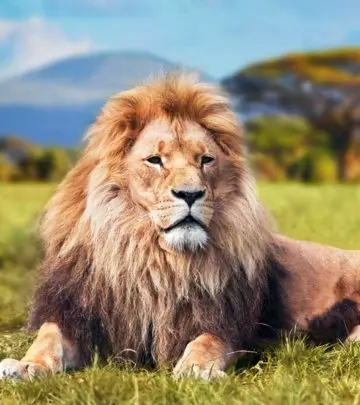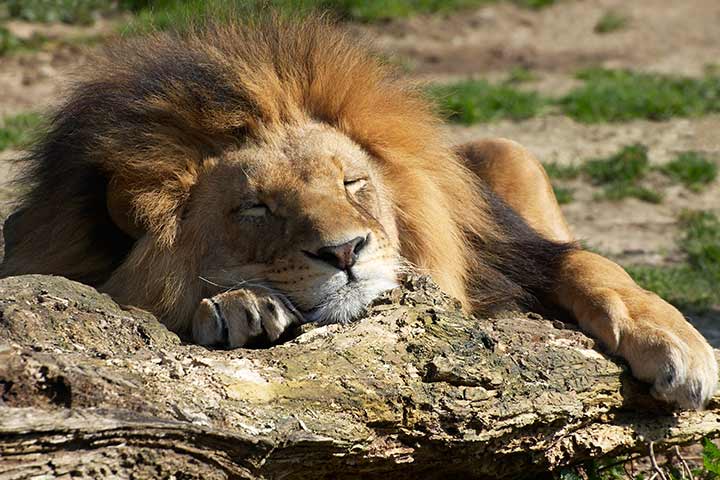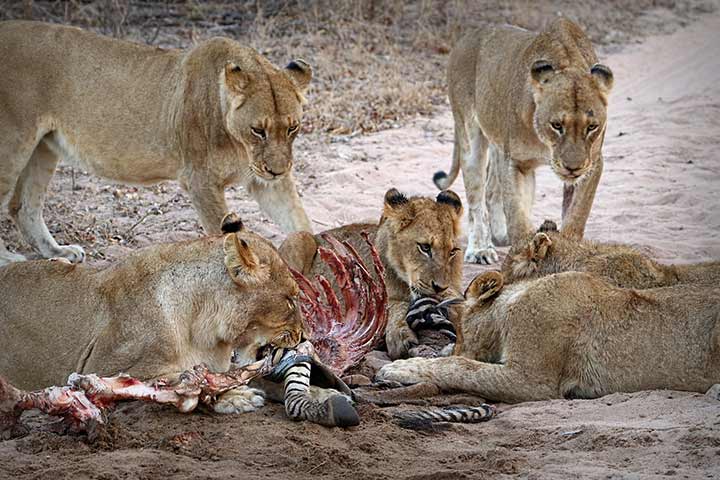
Image: Shutterstock
Lion facts for kids are sure to fascinate and fill them with awe. The golden mane, royal gaze, and fierce eyes are indeed a sight. Perhaps this is why a lion is known as the king of the jungle.
If your little one enjoys learning about animals and wants to know more about this wild animal, why not introduce them to the lion with some interesting facts so they learn with fun and zeal.
Known for its roar, the lion is ferocious and loves to protect and take care of its group called pride. If the idea of a lion excites you and you want your child to know more about them, here is a list of fun facts about a lion that you should read about.
55 Interesting Facts About Lions
The earliest lion fossils, considered to be 1.4 to 1.2 million years old, were found at Olduvai Gorge in Tanzania. It appears that the species spread out from Africa and moved to different parts of the world where it thrived. Keep reading for some more interesting facts about lions for kids.
- Lions belong to the Felidae family. It is a pedigree of meat-eating animals commonly known as cats.
- Lions are the second largest big cat species in the world.
- The scientific name for lions is Panthera leo.
- Lions are the national animal of Ethiopia, Kenya, Libya, Luxembourg, North Macedonia, the Netherlands, Norway, Sierra Leone, Singapore, Sri Lanka, Togo, and England.
 Did you Know?
Did you Know?- A baby lion is called a cub, lionet, or a whelp.
- The lifespan of a lion living in the wild ranges between 10 and 14 years.
- Lions are carnivorous, and they usually hunt big animals. A female lion needs approximately 5 kilograms of meat, and a male eats about 7 kilograms of meat every single day.
- Sometimes, a lion is referred to as hyper-carnivore as meat forms about 80% of its diet.
- Usually, female lions hunt for pride while the male lions protect the territory and their cubs. They usually hunt from dusk till dawn.
- A lion can run at a speed of 80 kilometers per hour.
- Lions are the laziest among all the big cats. They spend most of their time resting and can sleep for approximately 21 hours a day.
- A two-year-old female lion grows up to two-thirds of an adult’s size.
- They preferably inhabit the Savannah or grasslands.
- Lions are more social unlike the other members of the big cat family. Lions prefer to live in a pride that has more female lions and a few male lions to patrol and protect their territory and the cubs.
- The cubs are vulnerable to predators like leopards, hyenas, and black-backed jackals and have a mortality rate of 65-70%.
- A pride can be as small as three lions living together or as big as 40 lions together.
 Quick fact
Quick fact- On average, a female lion weighs 120 to 182 kilograms. Male lions are much bigger and heftier than female lions and weigh nearly 150 to 250 kilograms.
- The length of lions can be anything between 4.5 to 6.5 feet.
- The height of a male lion is about 72 to 84 inches, and that of female lions can be 63 to 72 inches tall.
- A lion’s mane is the most distinct feature that separates it from the others in the cat family. The mane starts growing at the age of one; lions with a darker mane have higher reproductive strength when compared to other lions.
 Did you know?
Did you know?- The gestation period of a lion is four months or 110 days. Like other cats, lionesses prefer to hide away while giving birth.
- A lioness can give birth to 2-4 babies at a time and keeps the infant cubs hidden for the first six weeks. Later, all the females of the pride take care of the cubs.
- A newborn cub weighs around 1.5 kilograms at the time of birth.
- Most wild lion populations lie in the southern and eastern parts of Africa.
- Lions can leap as high as 36 feet. (Jaw-dropping!)
- Lions are ready to mate by the age of 3 or 4 years.
- African lions eat larger animals like zebras, antelopes, and other wild beasts. The Asiatic lions, on the other hand, eat large as well as smaller animals.
- White lions are a rare find. Their skin color is due to a rare genetic condition caused by leucism.
- When the water is scarce, the lions drink fluids from wild melons. This is to avoid dehydration and retain moisture in their bodies.
- The territory of a lion can range anywhere from 260 to 300 square kilometers.
- Lionesses work together in a team while hunting, and the whole pride shares the kill. But they follow an order: the males eat first, then the females, and lastly the cubs.
- The digestive system of lions is pretty fast, which is why they go for a hunt not long after they’re devoured the previous kill.
- When close to a source of water, lions drink water every day. But they can also go without water for 4-5 days as they obtain moisture from the bodies of their prey.
- Lions are among the animals that are at the top of the food chain, which is why they are also referred to as the alpha predators.
- Lions become weak and worn between the age of 10 and 15.
Fun Facts About Lions
A few fun facts about lions for kids are actually roarsome enough to intrigue them and put their little minds to work. Here are some such fascinating facts about this big cat species.
- Did you know? The roar of an adult male lion can be heard from 5 miles or 8 kilometers away.
- When lions are kept in captivity they are also bred with other big cats like tigers, leopards or jaguars. The resulting hybrids are referred to as ligers, tigons, leopons or jaglions.
- Female lions are attracted more to male lions with darker manes.
- Simba, weighing 380 kilograms, is the heaviest lion on record till date. He was kept captive at Colchester Zoo in England.
- While walking, the heels of a lion do not touch the ground.
- Lions have to protect their dead prey from hyenas and vultures so that it can serve as another meal for them.
- Cubs and young lions do not take part in hunting, but the adult lions train them by showing them the stalking behavior. The cubs start training in hunting when they are one or two years old.
- Lions have a denture formula of 3.1.3.1 / 3.1.2.1, with a total of 30 teeth. Their canine teeth are exceptionally big and are used for hunting and killing the prey.
- Lions do not chew; they directly swallow the food after chopping or ripping it apart from the body of their prey.
- Lion cubs are born just like puppies and kittens and do not open their eyes until one week after birth.
- Cubs are entirely dependent on their mommies for feeding and nourishment in the initial three months of birth, after which they are introduced to meat.
 Quick fact
Quick fact- Lionesses do not entertain or tolerate any female lion from outside of their pride, as they have a fixed social unit consisting of their own family.
- When another male lion attacks or usurps a pride, he kills all the males and the cubs but not the females.
- Lions are very sharp-sighted as they have five times better eyesight than human beings.
Are Lions At Risk?
Lions are among those at the top of the food chain and have no other predators. But is that entirely true? Unfortunately, No! Because lions have predators too and sadly it’s us. Humans! Here is some information about the risks that lions are at because of the human race.
- Lion hunting or trophy hunting is still legal in some countries. This is one of the leading causes of reduction in their population since 1880 when there were more than 1.2 million African Lions in the world.
- These majestic big cats, especially the African Lions, are also threatened due to a loss in their natural habitat. Lions are listed as vulnerable in the International Union for Conservation of Nature, Red List of Threatened Species.
- We are left with less than 40,000 lions on our planet now.
- Asiatic lions have been on the International Union for Conservation of Nature and the Red List of Endangered Species since 2008. Asiatic Lions are found only in India’s Gir Forest National Park and the surrounding areas in Gujarat state, which is the only habitat of lions in all of Asia. The population of lions living here is critically endangered.
- Lions are at a high risk of poaching. It is due to the illegal hunting of lions for their bones, which are used in traditional medicines as well as in vineyards for making expensive wines.
- Another important cause for the decline in their population can sometimes be conflicts with humans, scarcity in finding food and prey due to shrinking forests.
How Many Types Of Lions Are There?
Lions are in two distinct types: the Northern Lion, also known as the ‘African lion’ (Panthera leo leo), and the Southern Lion, referred to as the ‘melanochaita subspecies’ (Panthera leo melanochaita). The Northern Lion hangs out in west and central Africa, and it used to have the Barbary lion in its crew, but sadly, that lion is now extinct in the wild. This group also includes the Asiatic or Asian lions. On the flip side, the Southern Lion, part of the ‘melanochaita subspecies,’ rules the southern and east African territories. They’re like two lion clubs with their territories on the African turf (2).
Frequently Asked Questions
1. Can lions swim?
Yes, lions can swim. However, they avoid getting into the water unless they need to hunt their prey.
2. Are lions friendly to humans?
Yes, tamed lions can be friendly to humans and exhibit affection. However, they remain wild and ferocious if you let your guards down before them.
3. What are lions afraid of?
Lions are predators at the top of the food chain, so they are not afraid of many animals.
4. What do lions do when happy?
Lions can express happiness in several ways, just like humans. For example, they might let out a contented roar, playfully chase each other, or rub their heads and bodies against each other as a sign of affection.
5. Who can defeat a lion?
Lions are apex predators. However, a few animals could defeat a lion, such as an elephant or a hippopotamus. These animals are much larger and more robust than a lion and could potentially injure or kill a lion if they were to fight.
Learning about the mighty lions, their habitat, life, and social behavior can raise your child’s curiosity. These big cats can attain a speed of 80 kilometers per hour and leap an unbelievable 36 feet, but they also love to sleep a lot and may sleep up to 21 hours a day. The females of these alpha predators hunt and gather food while males protect their territory. Sadly, illegal hunting has greatly affected their population. Share these and other lion facts for kids to teach them about these majestic animals and the importance of conservation of the ecology. You may use documentaries, videos, or movies about lions to satiate your children’s desire to learn. You can also take your children on a jungle safari to witness the majestic animal live.
Infographic: Lion Reserves Across The World
Lions ooze power and dominance through their aura. If your children are fascinated by this majestic animal, you may want to take notes from this infographic to plan your next trip to the best place to see lions in the wild. Illustration: Momjunction Design Team
Key Pointers
- Lions are the second largest big cats in the world and belong to the Panthera genus of the Felidae family.
- They are national animals in several countries and mainly inhabit grasslands in groups called Prides.
- Lion prides comprise more females and cubs than males, and they are hyper-carnivores.
- These alpha predators are territorial, sociable, and protective of their cubs, and work as a team.
- Lions are endangered due to poaching and trophy hunting, and are kept in captivity in zoos, national parks, and wildlife reserves to prevent depletion.

Image: Stable Diffusion/MomJunction Design Team
References
- Top 10 facts about lions.
https://www.wwf.org.uk/learn/fascinating-facts/lions - Lions.
https://www.zsl.org/what-we-do/species/lions
Discover amazing facts about lions in this fun and educational animation! Check out this video to unveil insights into their habitats, diets, and more! Perfect for engaging elementary and primary school students.




























